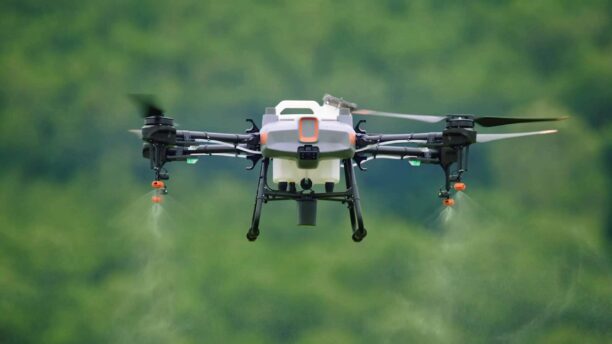The global agricultural drone industry is experiencing unprecedented growth, with adoption rates soaring as regulatory frameworks mature and technology advances. According to DJI Agriculture‘s fourth annual Agricultural Drone Industry Insight Report, unveiled at Brazil’s Agrishow 2025, agricultural drones have become essential farm equipment worldwide, transforming traditional farming practices while delivering significant environmental and economic benefits.
Despite the progress made and increasing recognition of the significant benefits that drones provide, growers still face major barriers to adoption. Here, we dive into the ultimate outlook for the agricultural drone sector, and what needs to happen to ensure continued growth.
Record-Breaking Industry Growth and Environmental Impact
By the end of 2024, approximately 400,000 DJI Agriculture drones were in use globally, representing a remarkable 90% increase from 2020. These drones have collectively treated over 500 million hectares across more than 100 countries, serving over 300 types of crops. The widespread adoption has yielded impressive environmental benefits, with cumulative water savings of approximately 222 million tons and reduced carbon emissions of 30.87 tons.
According to earlier reports, agricultural drones have significantly reduced chemical product usage by 47,000 metric tons and cut carbon emissions by 25.72 million metric tons – equivalent to the annual carbon sequestration of 1.2 billion trees. These environmental gains highlight the technology’s contribution to sustainable farming practices.
The industry’s growth is supported by a robust training infrastructure, with 6,000 instructors having trained approximately 300,000 pilots globally. Yuan Zhang, Head of Global Sales at DJI Agriculture, noted: “Thanks to research-based policies and a clearer process for operator training, adoption among young people and women has grown significantly.”
Regulatory Evolution Accelerates Adoption
A key factor driving the agricultural drone boom has been the evolution of regulatory frameworks worldwide. Aviation authorities are increasingly implementing farmer-friendly policies to accelerate precision farming adoption. For example, Brazil’s ANAC has amended regulations to streamline requirements, now only requiring drone registration and pilot licensing before operations can begin. Similarly, Argentina has reduced restrictions for drone deployment in agricultural areas, while Spain has simplified the approval process for agricultural drone usage.
These regulatory advances represent a significant shift from previous approaches, with many nations now classifying agricultural drones as low-risk aircraft and providing guidance for their use in agricultural spraying similar to ground-based equipment regulations.
Technical Advancements Address Key Challenges
Limiting pesticide drift continues to be a challenge for all application methods, including drones. DJI Agriculture has made significant progress in this area by optimizing nozzle design and airflow dynamics following extensive drifting tests conducted with global partners from 2021 to 2024. The company has also developed comprehensive best practices for minimizing drift, including recommended wind speed conditions, appropriate flight altitudes, and optimal droplet sizes based on different pesticides and field conditions.
These technical improvements address one of the most significant concerns in agricultural drone applications and demonstrate the industry’s commitment to continuous innovation.
Case Studies Demonstrate Transformative Impact
DJI’s white paper report highlights several compelling case studies that demonstrate the transformative impact of agricultural drones:
Coffee Production in Brazil
Using the DJI Agras T40 and T50 drones to apply pesticides, fungicides, and foliar fertilizers has reduced operational costs for Brazilian coffee growers by 70% compared to manual spraying and 50% compared to tractor spraying. This dramatic cost reduction demonstrates the significant economic benefits agricultural drones can deliver.
Vineyard Management in Romania
An elderly vineyard owner using the DJI Agras T50 was able to reduce chemical usage by half, from 241.64 liters to 111.94 liters. Perhaps more importantly, the time required for spraying was reduced from 3-4 days to just 2.5 hours. The drone’s ability to effectively treat crops on sloped terrain, even after rain, provided advantages impossible with traditional tractors.
Persistent Headwinds to Drone Adoption
Despite the impressive growth and benefits, agricultural drone adoption still faces several significant challenges:
Cost Barriers
The cost of acquiring and maintaining agricultural drones remains a substantial barrier, especially for small to medium-sized farms. A complete drone solution (including analytics software, training modules, and charging equipment) can cost around $5,000, making it unaffordable for many smaller farmers in low and lower-middle-income countries. However, prices have been decreasing over time – the DJI Agras MG-1 crop spraying drone, for example, saw its price drop from almost $15,000 to about $5,000 in just a couple of years.
Technical Expertise Requirements
Operating drones and analyzing the data they collect requires specialized skills. The steep learning curve can deter many farmers from adopting this new technology. Managing and interpreting the large volumes of data generated by drones presents another significant challenge, particularly for farmers unfamiliar with data analytics.
Connectivity and Infrastructure Limitations
Insufficient internet access, especially in rural areas, impedes the widespread adoption of precision agriculture techniques. Many farms globally still operate with outdated infrastructure that hinders the integration of advanced precision agriculture technologies. The lack of standardization across platforms and systems leads to data silos, preventing farmers from realizing the full benefits of their drone investments.
Scale and Efficiency Considerations
For large-scale operations, drones may be less efficient compared to traditional methods. Crop spraying drones are effective for hills, small areas, and places where other equipment cannot easily reach, but for crop spraying over large distances, they are currently less efficient and more costly than larger ground-based equipment. Similarly, for NVDI imaging, drones are cost-effective for small areas but not competitive against planes and satellites for larger areas.
Demographic and Educational Barriers
The aging farming population in many regions exhibits risk aversion to new technologies, impacting the pace of adoption. Additionally, lack of digital education among smallholders poses challenges in embracing precision agriculture techniques. In some regions, farmers have little awareness of agricultural drone capabilities and their potential benefits.
The Path Forward
Despite these challenges, the agricultural drone industry continues to evolve and adapt. Several promising developments are helping to address adoption barriers:
-
Drone-as-a-service business models are making the technology accessible to farmers who cannot afford to purchase their own equipment.
-
Simplified drone offerings with reduced complexity are being developed for smallholder farmers based on affordability and necessary features for smaller farms. In some regions, drones are available for as little as $400
-
Comprehensive training programs are expanding, with DJI conducting team and content integration to provide more advanced training for partners combined with crop-specific solutions.
-
Research-based policies are continuing to evolve, making it easier for farmers to legally operate agricultural drones.
As the industry continues to mature, agricultural drones are poised to become an increasingly integral part of modern farming practices, helping farmers improve efficiency and sustainably increase their yields through innovative technology.
Read more:


Miriam McNabb is the Editor-in-Chief of DRONELIFE and CEO of JobForDrones, a professional drone services marketplace, and a fascinated observer of the emerging drone industry and the regulatory environment for drones. Miriam has penned over 3,000 articles focused on the commercial drone space and is an international speaker and recognized figure in the industry. Miriam has a degree from the University of Chicago and over 20 years of experience in high tech sales and marketing for new technologies.
For drone industry consulting or writing, Email Miriam.
TWITTER:@spaldingbarker
Subscribe to DroneLife here.


